Full Year and Fourth Quarter Highlights:
-
Full year total revenues increased to $268.7 billion, up 4.6% compared to prior year
-
Full year and fourth quarter GAAP diluted earnings per share from continuing operations of $5.47 and $0.75
-
Full year and fourth quarter Adjusted EPS of $7.50 and $1.30
-
Generated full year cash flow from operations of $15.9 billion
-
Results reflect COVID-19 impacts and related investments
2021 Full Year Guidance:
-
GAAP diluted EPS from continuing operations in the range of $6.06 to $6.22
-
Adjusted EPS in the range of $7.39 to $7.55
-
Cash flow from operations in the range of $12.0 billion to $12.5 billion
WOONSOCKET, RHODE ISLAND — CVS Health Corporation (NYSE: CVS) today announced operating results for the three months and year ended December 31, 2020.
CVS Health President and CEO Karen S. Lynch stated, “The COVID-19 pandemic presented unique challenges to our business and to the entire health care industry. We utilized the full depth and breadth of our capabilities and our presence in local communities across the country to play a leadership role in COVID-19 testing and vaccine administration. Our ability to deliver 2020 full year results above expectations is a testament to the strength of our strategy and the flexibility of our diversified health services model.
“We are proud to be a trusted health partner to more than 100 million customers through our Pharmacy and Health Care businesses and to be able to support millions of Americans in our local communities, many in underserved and remote areas. We are grateful for the dedication of our nearly 300,000 colleagues, many serving on the frontlines, who demonstrated an unwavering commitment to our fellow Americans.
“Our goal is to make health care more accessible, more affordable and simpler. In order to do this, we will accelerate the pace of our progress through targeted investments in key areas that will drive our consumer-focused strategy. We believe that solving consumer health needs will deliver better health outcomes and lower costs while creating future economic benefit for CVS Health and its shareholders.”
A summary of the Company’s response to the COVID-19 pandemic is included on page six.
The Company presents both GAAP and non-GAAP financial measures in this press release to assist in the comparison of the Company’s past financial performance with its current financial performance. See “Non-GAAP Financial Information” on pages 12 through 13 and endnotes on page 25 for explanations of non-GAAP financial measures presented in this press release. See pages 14 through 17 and page 24 for reconciliations of each non-GAAP financial measure to the most directly comparable GAAP financial measure.
Consolidated Fourth Quarter and Full Year Results

-
Total revenues increased 4.0% and 4.6% for the three months and year ended December 31, 2020, respectively, compared to the prior year primarily driven by growth in the Health Care Benefits and Retail/LTC segments.
-
Operating income and adjusted operating income decreased 16.9% and 21.8%, respectively, for the three months ended December 31, 2020 compared to the prior year. The decrease in both operating income and adjusted operating income was primarily due to the impact of the COVID-19 pandemic in the Health Care Benefits and Retail/LTC segments, as well as continued reimbursement pressure in the Retail/LTC segment, partially offset by improved purchasing economics in the Pharmacy Services segment and the favorable impact of enterprise-wide cost savings initiatives in 2020. The decrease in operating income was also partially offset by pre-tax income of $307 million associated with the receipt of amounts owed to the Company under the Patient Protection and Affordable Care Act and the Health Care and Education Reconciliation Act of 2010 (collectively, the “ACA”) risk corridor program that was previously fully reserved for as payment was uncertain.
-
Operating income and adjusted operating income increased 16.1% and 4.4%, respectively, for the year ended December 31, 2020 compared to the prior year. The increase in both operating income and adjusted operating income was primarily due to the net impact of the COVID-19 pandemic, improved purchasing economics in the Pharmacy Services segment and the favorable impact of enterprise-wide cost savings initiatives in 2020, partially offset by continued reimbursement pressure in the Retail/LTC segment. The impact of the COVID-19 pandemic resulted in increases in both operating income and adjusted operating income in the Health Care Benefits segment, which were partially offset by declines in the Retail/LTC segment as further described later in our segment discussion. The increase in operating income was also driven by (i) pre-tax income of $307 million associated with the receipt of amounts owed to the Company under the ACA risk corridor program, (ii) a $269 million pre-tax gain on the sale of the Company’s Coventry Health Care Workers’ Compensation business (“Workers’ Compensation business”) and (iii) the absence of $231 million of store rationalization charges and a $205 million pre-tax loss on the sale of the Company’s Brazilian subsidiary, Drogaria Onofre Ltda. (“Onofre”), both recorded in the year ended December 31, 2019.
-
Net income decreased 44.1% for the three months ended December 31, 2020 compared to the prior year primarily due to the lower operating income described above and a loss on early extinguishment of debt of $674 million in the three months ended December 31, 2020, partially offset by lower income tax expense primarily driven by the decrease in pre-tax income. Net income increased 8.5% for the year ended December 31, 2020 compared to the prior year primarily due to the higher operating income described above and lower interest expense primarily due to lower average debt in 2020, partially offset by an increase in the loss on early extinguishment of debt to $1.4 billion in 2020, compared to $79 million in 2019 and higher income tax expense primarily driven by the increase in pre-tax income.
-
The effective income tax rate was 19.7% for the three months ended December 31, 2020 compared to 25.3% for the three months ended December 31, 2019. The decrease in the effective income tax rate was primarily attributable to the timing of the realization of certain tax items during the third and fourth quarters of 2020, partially offset by the reinstatement of the non-deductible health insurer fee (“HIF”) for 2020. The effective income tax rate remained consistent at 26.3% for each of the years ended December 31, 2020 and December 31, 2019, with the impact of the non-deductible HIF offset by the favorable resolution of certain tax matters in the year ended December 31, 2020.
Pharmacy Services Segment
The Pharmacy Services segment provides a full range of pharmacy benefit management solutions to employers, health plans, government employee groups and government sponsored programs. The segment results for the three months and years ended December 31, 2020 and 2019 were as follows:

-
Total revenues decreased 1.9% for the three months ended December 31, 2020 compared to the prior year primarily driven by continued price compression and changes in net new business mix, partially offset by growth in specialty pharmacy and brand inflation. Total revenues increased 0.3% for the year ended December 31, 2020 compared to the prior year primarily driven by growth in specialty pharmacy and brand inflation, partially offset by continued price compression and changes in net new business mix.
-
Total pharmacy claims processed increased 0.7% and 4.9%, on a 30-day equivalent basis, for the three months and year ended December 31, 2020, respectively, compared to the prior year primarily driven by net new business.
-
Operating income and adjusted operating income increased 11.6% and 7.9%, respectively, for the three months ended December 31, 2020 compared to the prior year. Operating income and adjusted operating income increased 15.2% and 10.9%, respectively, for the year ended December 31, 2020 compared to the prior year. The increase in operating income and adjusted operating income in both periods was primarily driven by improved purchasing economics and growth in specialty pharmacy, partially offset by continued price compression. The increase in operating income in both periods also was driven by lower amortization expense in the three months and year ended December 31, 2020.
See the supplemental information on page 19 for additional information regarding the performance of the Pharmacy Services segment.
Retail/LTC Segment
The Retail/LTC segment fulfills prescriptions for medications, provides patient care programs, sells a wide assortment of health and wellness products and general merchandise, provides health care services through walk-in medical clinics, provides medical diagnostic testing and provides services to long-term care facilities. The segment results for the three months and years ended December 31, 2020 and 2019 were as follows:

-
Total revenues increased 6.6% and 5.3% for the three months and year ended December 31, 2020, respectively, compared to the prior year primarily driven by increased prescription volume, COVID-19 diagnostic testing and brand inflation, partially offset by continued reimbursement pressure and the impact of recent generic introductions.
-
Front store revenues decreased 1.6% for the three months ended December 31, 2020 compared to the prior year primarily due to decreased customer traffic and reduced volume in cough and cold product sales largely as a result of the COVID-19 pandemic. Front store revenues increased 1.2% for the year ended December 31, 2020 compared to the prior year primarily due to increases in consumer health and general merchandise sales.
-
Total prescription volume grew 2.0% and 3.4%, on a 30-day equivalent basis, for the three months and year ended December 31, 2020, respectively, compared to the prior year primarily driven by the continued adoption of patient care programs. The increase was partially offset by reduced new therapy prescriptions, including lower seasonal flu prescriptions, as a result of the COVID-19 pandemic as well as decreased long-term care prescription volume.
-
Operating income and adjusted operating income decreased 13.9% and 12.6%, respectively, for the three months ended December 31, 2020 compared to the prior year. Operating income and adjusted operating income decreased 2.6% and 8.3%, respectively, for the year ended December 31, 2020 compared to the prior year. The decrease in operating income and adjusted operating income in both periods was primarily due to continued reimbursement pressure and the net impact of the COVID-19 pandemic, partially offset by the increased pharmacy volume described above and improved generic drug purchasing. The COVID-19 pandemic resulted in reduced operating income and adjusted operating income in both periods as a result of decreased customer traffic in the segment’s retail pharmacies and MinuteClinic® locations and incremental operating expenses associated with the Company’s COVID-19 pandemic response efforts, partially offset by COVID-19 diagnostic testing. The decrease in operating income in the year ended December 31, 2020 also was partially offset by the absence of the $231 million of store rationalization charges and the $205 million pre-tax loss on the sale of Onofre, both recorded in the year ended December 31, 2019.
See the supplemental information on page 20 for additional information regarding the performance of the Retail/LTC segment.
Health Care Benefits Segment
The Health Care Benefits segment offers a full range of insured and self-insured (“ASC”) medical, pharmacy, dental and behavioral health products and services. The segment results for the three months and years ended December 31, 2020 and 2019 were as follows:

-
Total revenues increased 11.4% and 8.4%, respectively, for the three months and year ended December 31, 2020 compared to the prior year primarily driven by membership growth in the Health Care Benefits segment’s Government products, the favorable impact of the reinstatement of the HIF for 2020 and the receipt of $313 million owed to the Company under the ACA’s risk corridor program. These increases were partially offset by the divestitures of Aetna’s standalone Medicare Part D prescription drug plans (which the Company retained the financial results of through 2019) and Workers’ Compensation business, membership declines in the segment’s Commercial products and planned COVID-19 related investments benefiting customers in the three months and year ended December 31, 2020.
-
Operating income and adjusted operating income decreased 85.5% and 80.4%, respectively, for the three months ended December 31, 2020 compared to the prior year. The decrease in both operating income and adjusted operating income was primarily driven by COVID-19 related investments, testing and treatment costs, as well as the divestitures of Aetna’s standalone Medicare Part D prescription drug plans (“PDPs”) and Workers’ Compensation business. Operating income also includes pre-tax income of $307 million associated with the receipt of amounts owed to the Company under the ACA’s risk corridor program in the three months ended December 31, 2020.
-
Operating income and adjusted operating income increased 42.0% and 19.0%, respectively, for the year ended December 31, 2020 compared to the prior year. The increase in both operating income and adjusted operating income was primarily driven by the impact of the COVID-19 pandemic, partially offset by the divestitures of Aetna’s standalone PDPs and Workers’ Compensation business. The COVID-19 pandemic resulted in reduced benefit costs due to the deferral of elective procedures and other discretionary utilization, partially offset by COVID-19 related investments, testing and treatment costs. Operating income also includes pre-tax income of $307 million associated with the receipt of amounts owed to the Company under the ACA’s risk corridor program and the $269 million pre-tax gain on the sale of the Workers’ Compensation business in the year ended December 31, 2020.
-
The Health Care Benefits segment’s MBR increased 100 basis points and decreased 330 basis points in the three months and year ended December 31, 2020, respectively, compared to the prior year. The increase in the three months ended December 31, 2020 was primarily driven by the COVID-19 related investments, testing and treatment costs described above, partially offset by the receipt of amounts owed to the Company under the ACA’s risk corridor program in 2020 and the reinstatement of the HIF for 2020. The decrease for the year ended December 31, 2020 was primarily due to the full year impact of the COVID-19 pandemic described above, the reinstatement of the HIF for 2020 and the receipt of amounts owed to the Company under the ACA’s risk corridor program in 2020. The receipt of the ACA risk corridor payment reduced our MBR by 160 and 40 basis points during the three months and year ended December 31, 2020, respectively.
-
Medical membership as of December 31, 2020 of 23.4 million increased compared with September 30, 2020, primarily reflecting increases in Medicaid and Medicare products, partially offset by a decline in Commercial products.
-
The Health Care Benefits segment experienced favorable development of prior-periods’ health care cost estimates during the three months ended December 31, 2020 driven by favorable development in its Government business, primarily attributable to third quarter 2020 performance, partially offset by unfavorable development in its Commercial business, largely driven by higher than expected costs related to the COVID-19 pandemic for the third quarter of 2020 as well as provider settlement activity.
-
Prior years’ health care costs payable estimates developed favorably by $429 million during the year ended December 31, 2020. This development is reported on a basis consistent with the prior years’ development reported in the health care costs payable table in the Company’s annual audited financial statements and does not directly correspond to an increase in 2020 operating results.
See the supplemental information on page 21 for additional information regarding the performance of the Health Care Benefits segment.
COVID-19 Response
CVS Health is uniquely positioned to help the country through the COVID-19 pandemic. The Company has focused its resources on the wellbeing and safety of employees, consumers and the communities it serves. The following are key actions taken to date:
Employees
-
Providing regular supply of personal protective equipment and adding safety features to retail stores.
-
Provided enhanced benefits, including bonuses to frontline employees, dependent care, paid sick leave for part-time employees and paid time off to employees who test positive or are quarantined due to exposure.
-
Hired over 15,000 clinicians and pharmacy technicians in the fourth quarter as part of our readiness investments.
Consumers and members
-
Extended waivers for out-of-pocket costs for inpatient hospital admissions for treatment or health complications associated with COVID-19 for Commercial members through January 31, 2021 and Medicare Advantage members through March 31, 2021.
-
Extended waivers for cost-sharing for in-network telemedicine visits by Commercial members for outpatient behavioral and mental health counseling services through January 31, 2021.
-
Extended waivers for Individual Medicare Advantage member out-of-pocket costs for all in-network primary care visits and outpatient behavioral health counseling telehealth services through the end of the public health emergency.
-
Extended waivers for cost-sharing for covered in-network telemedicine visits for medical and behavioral health services for Aetna Student Health plan members through January 31, 2021.
-
Sent care packages to members diagnosed with COVID-19 through Aetna’s Healing Better program and Caring for You kits to Medicare members enrolled on or before August 1, 2020.
-
Proactively reached out to over one million most at-risk members for COVID-19.
-
Opened crisis response line for members experiencing anxiety related to COVID-19 and expanded 24/7 access to Aetna Nurse Medical line for Aetna and Caremark members.
-
Expanded telehealth options (“E-Clinic”) offered by MinuteClinic to help patients access safe, affordable and convenient non-emergency care.
-
Extended maintenance prescriptions and waived early refill limits to support medication adherence.
-
Waived fees associated with prescription home delivery and associated front store products.
Plan Sponsors
-
Launched Return Ready, a comprehensive configurable and integrated end-to-end COVID-19 testing solution to assist employers and universities with the return of their employees, students and staff.
-
Provided assistance through premium credits.
Providers
-
Waived advance approvals, streamlined credentialing process, relaxed telemedicine policies and removed prior authorization requirements. Offering flexible plan designs to help reduce financial burdens.
Communities
-
Administered approximately 15 million COVID-19 tests nationwide to date at more than 4,800 CVS Pharmacy locations with over 50% located in communities with significant need for support according to the CDC Social Vulnerability Index. Testing at these sites is available to children 10 years and older.
-
Administered more than three million COVID-19 vaccines in over 40,000 long-term care facilities across the country.
-
Selected as national partner of the Federal Pharmacy Program and began initial rollout of in-store vaccinations at CVS Pharmacy locations in 11 states.
-
In coordination with the U.S. Department of Health and Human Services (“HHS”), opened 11 testing sites serving communities disproportionately impacted by COVID-19.
-
Launched critical diagnostic testing for the vulnerable senior population in long-term care facilities in partnership with three states.
-
Expanded Coram infusion services to help transition eligible IV-therapy patients to home-based care. Selected by U.S. Department of Health & Human Services, as part of a pilot, to administer recently authorized COVID-19 therapy to eligible patients in long-term care facilities and at home. And, collaborating with Cancer Treatment Centers of America to provide in-home chemotherapy for eligible, fully insured patients.
-
Investing more than $50 million directly and through the Company’s foundations to address food insecurity, lack of access to telehealth services for the underserved, personal protective equipment, mental health support for front-line workers and community resilience.
-
Donating nearly $40 million in products to community organizations around the country.
-
Served over one million meals to vulnerable populations.
-
Returned all $43 million in funds received from the Coronavirus Aid, Relief, and Economic Security Act provider relief fund to HHS.
2021 Full Year Guidance
The Company’s full year 2021 GAAP diluted EPS from continuing operations is projected to be in the range of $6.06 to $6.22, and full year 2021 Adjusted EPS is projected to be in the range of $7.39 to $7.55. The Company’s full year 2021 cash flow from operations is projected to be in the range of $12.0 billion to $12.5 billion.
The adjustments between GAAP diluted EPS from continuing operations and Adjusted EPS include, as applicable, adding back amortization of intangible assets, as well as integration costs related to the Company’s acquisition (the “Aetna Acquisition”) of Aetna Inc. (“Aetna”).
Teleconference and Webcast
The Company will be holding a conference call today for investors at 8:00 a.m. (Eastern Time) to discuss its fourth quarter and full year results and provide 2021 full year guidance. An audio webcast of the call will be broadcast simultaneously for all interested parties through the Investor Relations section of the CVS Health website at http://investors.cvshealth.com. This webcast will be archived and available on the website for a one-year period following the conference call.
About CVS Health
CVS Health is a different kind of health care company. We are a diversified health services company with nearly 300,000 employees united around a common purpose of helping people on their path to better health. In an increasingly connected and digital world, we are meeting people wherever they are and changing health care to meet their needs. Built on a foundation of unmatched community presence, our diversified model engages one in three Americans each year. From our innovative new services at HealthHUB® locations, to transformative programs that help manage chronic conditions, we are making health care more accessible, more affordable and simply better. Learn more about how we’re transforming health at www.cvshealth.com.
Cautionary Statement Concerning Forward-Looking Statements
The Private Securities Litigation Reform Act of 1995 provides a safe harbor for forward-looking statements made by or on behalf of CVS Health Corporation. Statements in this press release that are forward-looking include Ms. Lynch’s quotation, the information under the heading “2021 Full Year Guidance” and the information included in the endnotes and reconciliations. By their nature, all forward-looking statements are not guarantees of future performance or results and are subject to risks and uncertainties that are difficult to predict and/or quantify. Actual results may differ materially from those contemplated by the forward-looking statements due to the risks and uncertainties related to the COVID-19 pandemic, the geographies impacted and the severity and duration of the pandemic, the pandemic’s impact on the U.S. and global economies and consumer behavior and health care utilization patterns, and the timing, scope and impact of stimulus legislation and other federal, state and local governmental responses to the pandemic, as well as the risks and uncertainties described in our Securities and Exchange Commission (“SEC”) filings, including those set forth in the Risk Factors section and under the heading “Cautionary Statement Concerning Forward-Looking Statements” in our most recently filed Annual Report on Form 10-K and in our most recently filed Quarterly Report on Form 10-Q.
You are cautioned not to place undue reliance on CVS Health’s forward-looking statements. CVS Health’s forward-looking statements are and will be based upon management’s then-current views and assumptions regarding future events and operating performance, and are applicable only as of the dates of such statements. CVS Health does not assume any duty to update or revise forward-looking statements, whether as a result of new information, future events, uncertainties or otherwise.
– Tables Follow –
CVS HEALTH CORPORATION
Condensed Consolidated Statements of Operations
(Unaudited)
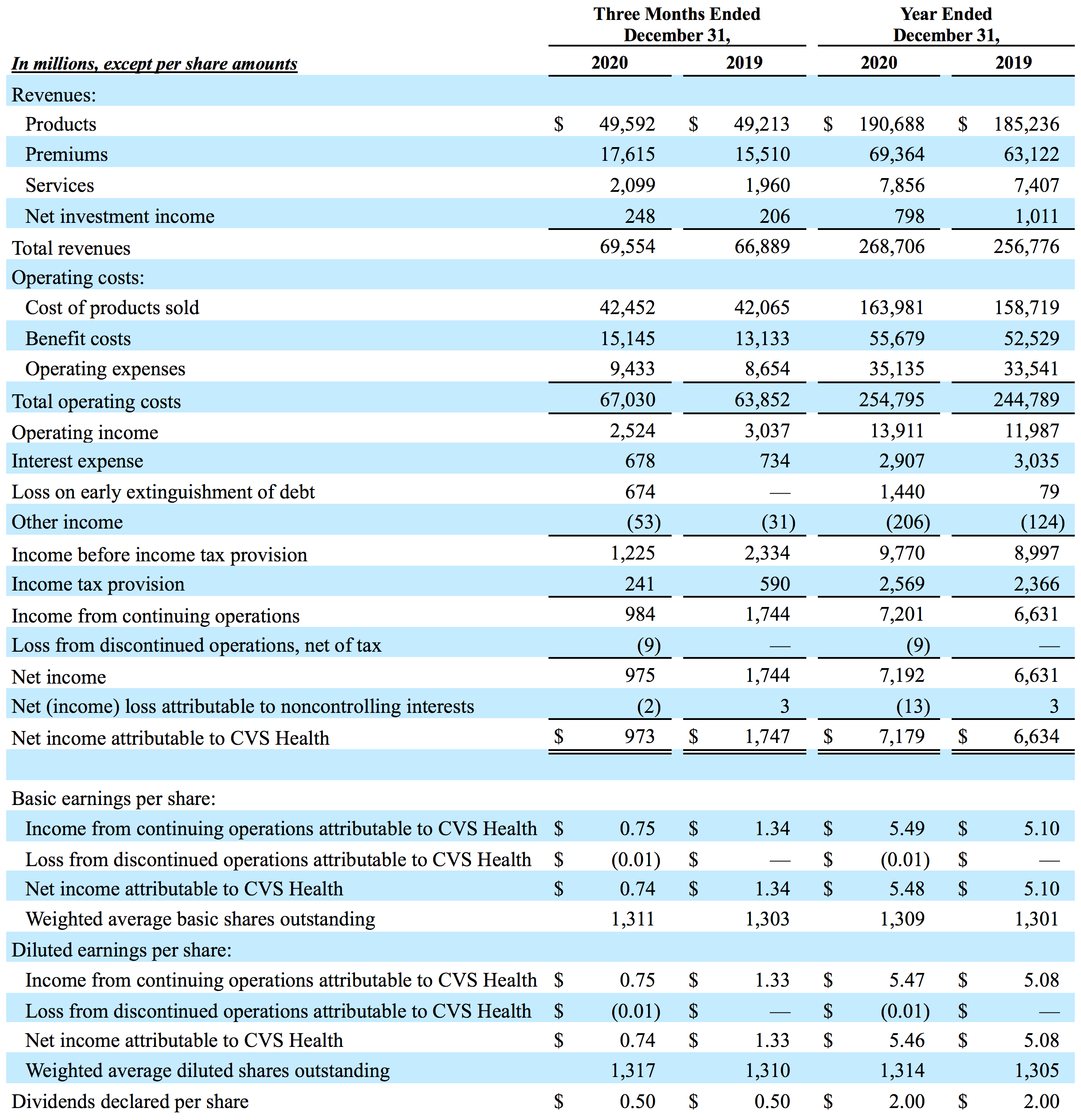
CVS HEALTH CORPORATION
Condensed Consolidated Balance Sheets
(Unaudited)
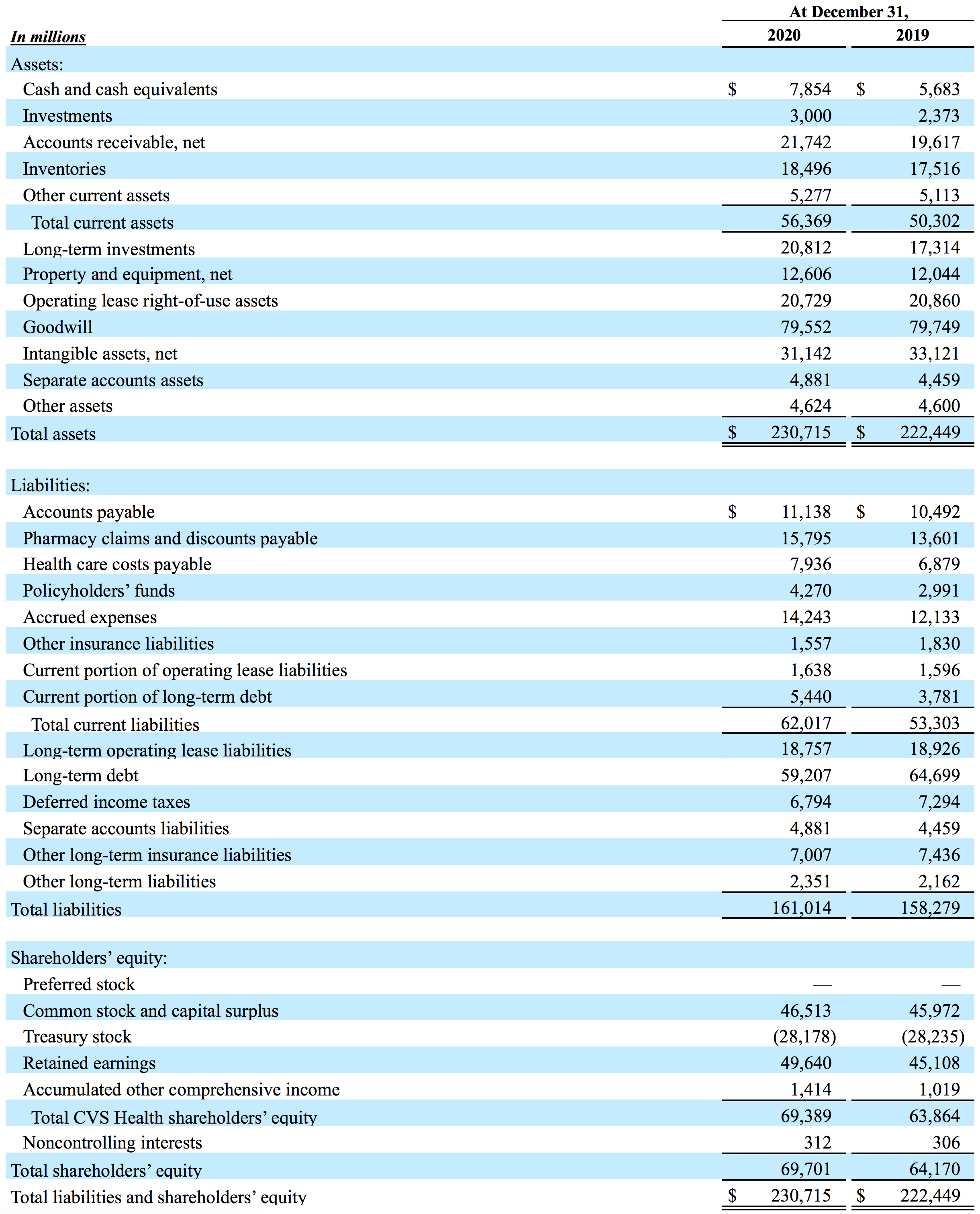
CVS HEALTH CORPORATION
Condensed Consolidated Statements of Cash Flows
(Unaudited)
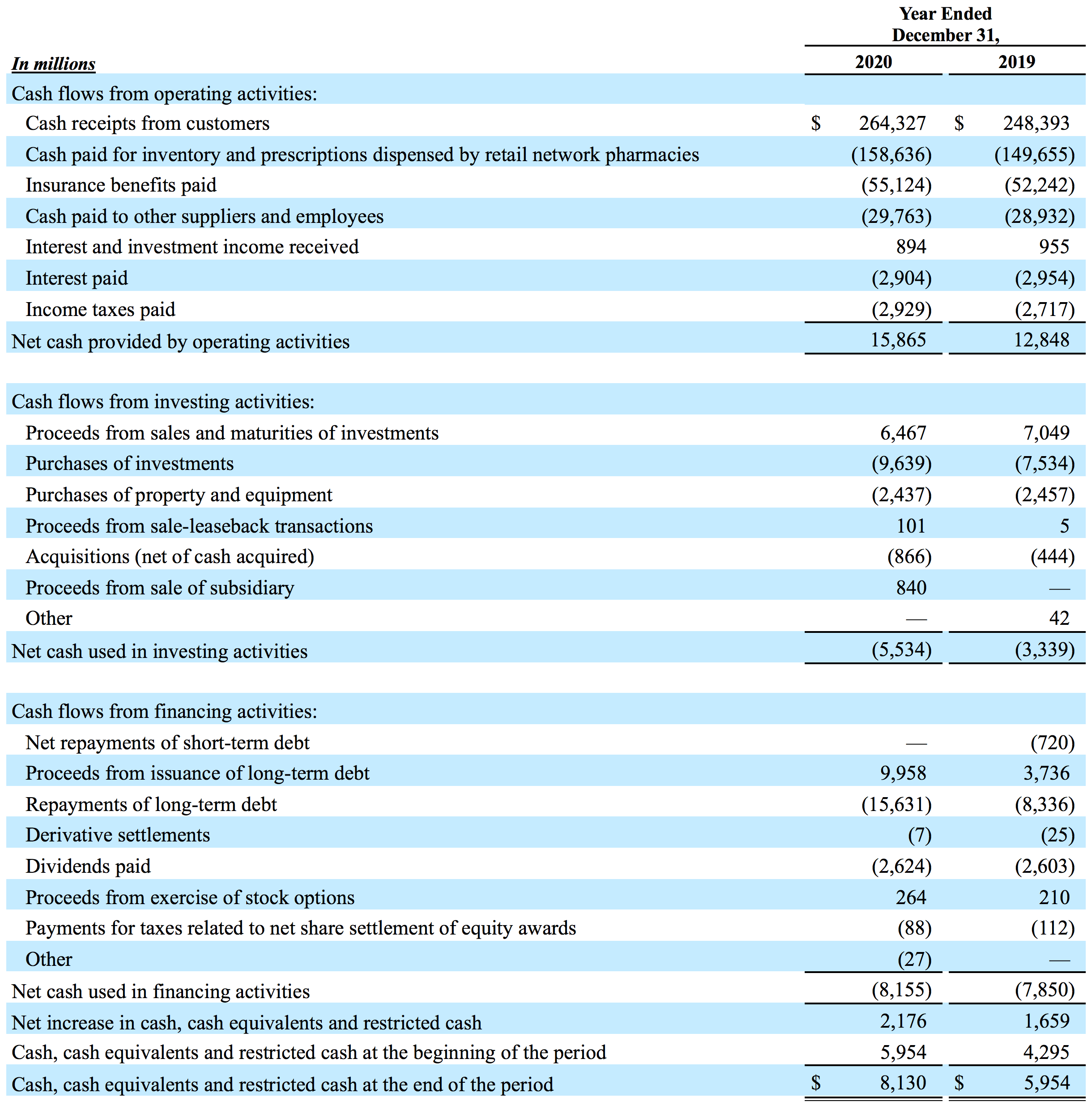
CVS HEALTH CORPORATION
Condensed Consolidated Statements of Cash Flows
(Unaudited)
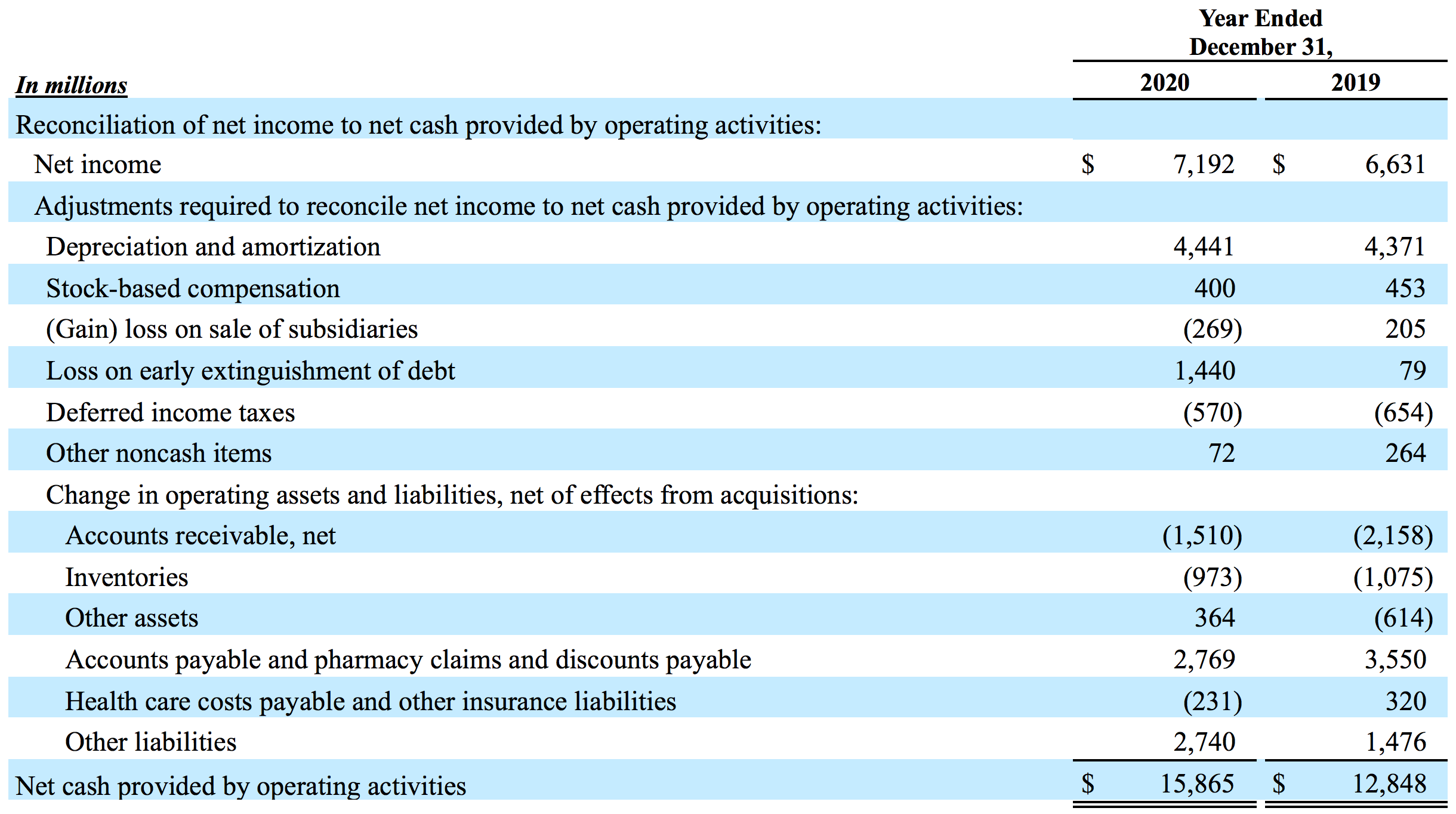
Non-GAAP Financial Information
The Company uses non-GAAP financial measures to analyze underlying business performance and trends. The Company believes that providing these non-GAAP financial measures enhances the Company’s and investors’ ability to compare the Company’s past financial performance with its current performance. These non-GAAP financial measures are provided as supplemental information to the financial measures presented in this press release that are calculated and presented in accordance with GAAP. Non-GAAP financial measures should not be considered a substitute for, or superior to, financial measures determined or calculated in accordance with GAAP. The Company’s definitions of its non-GAAP financial measures may not be comparable to similarly titled measures reported by other companies.
Non-GAAP financial measures such as adjusted operating income, adjusted earnings per share (“EPS”) and adjusted income from continuing operations attributable to CVS Health exclude from the relevant GAAP metrics, as applicable: amortization of intangible assets and other items, if any, that neither relate to the ordinary course of the Company’s business nor reflect the Company’s underlying business performance.
For the periods covered in this press release, the following items are excluded from the non-GAAP financial measures described above, as applicable, because the Company believes they neither relate to the ordinary course of the Company’s business nor reflect the Company’s underlying business performance:
-
The Company’s acquisition activities have resulted in the recognition of intangible assets as required under the acquisition method of accounting which consist primarily of trademarks, customer contracts/relationships, covenants not to compete, technology, provider networks and value of business acquired. Definite-lived intangible assets are amortized over their estimated useful lives and are tested for impairment when events indicate that the carrying value may not be recoverable. The amortization of intangible assets is reflected in the Company’s GAAP condensed consolidated statements of operations in operating expenses within each segment. Although intangible assets contribute to the Company’s revenue generation, the amortization of intangible assets does not directly relate to the underwriting of the Company’s insurance products, the services performed for the Company’s customers or the sale of the Company’s products or services. Additionally, intangible asset amortization expense typically fluctuates based on the size and timing of the Company’s acquisition activity. Accordingly, the Company believes excluding the amortization of intangible assets enhances the Company’s and investors’ ability to compare the Company’s past financial performance with its current performance and to analyze underlying business performance and trends. Intangible asset amortization excluded from the related non-GAAP financial measure represents the entire amount recorded within the Company’s GAAP financial statements, and the revenue generated by the associated intangible assets has not been excluded from the related non-GAAP financial measure. Intangible asset amortization is excluded from the related non-GAAP financial measure because the amortization, unlike the related revenue, is not affected by operations of any particular period unless an intangible asset becomes impaired or the estimated useful life of an intangible asset is revised.
-
During the three months and years ended December 31, 2020 and 2019, acquisition-related integration costs relate to the Aetna Acquisition. The acquisition-related integration costs are reflected in the Company’s condensed consolidated statements of operations in operating expenses within the Corporate/Other segment.
-
During the year ended December 31, 2020, the gain on divestiture of subsidiary represents the pre-tax gain on the sale of the Workers’ Compensation business, which the Company sold on July 31, 2020 for approximately $850 million. The gain on divestiture was finalized in the three months ended December 31, 2020 and is reflected as a reduction in operating expenses in the Company’s condensed consolidated statements of operations within the Health Care Benefits segment in the year ended December 31, 2020. During the year ended December 31, 2019, the loss on divestiture of subsidiary represents the pre-tax loss on the sale of Onofre, which occurred on July 1, 2019. The loss on divestiture primarily relates to the elimination of the cumulative translation adjustment from accumulated other comprehensive income and is reflected in operating expenses in the Company’s condensed consolidated statements of operations within the Retail/LTC segment.
-
During the three months and year ended December 31, 2020, the Company received $313 million owed to it under the ACA’s risk corridor program that was previously fully reserved for as payment was uncertain. After considering offsetting items such as the ACA’s minimum medical loss ratio (“MLR”) rebate requirements and premium taxes, the Company recognized pre-tax income of $307 million in the Company’s condensed consolidated statements of operations within the Health Care Benefits segment. The portion of the ACA risk corridor payment attributable to noncontrolling interest was $12 million related to third party ownership interests in the Company's consolidated operating entities.
-
During the year ended December 31, 2019, the store rationalization charges relate to the planned closure of 46 underperforming retail pharmacy stores in the second quarter of 2019 and the planned closure of 22 underperforming retail pharmacy stores in the first quarter of 2020. The store rationalization charges primarily relate to operating lease right-of-use asset impairment charges and are reflected in the Company’s condensed consolidated statements of operations in operating expenses within the Retail/LTC segment.
-
During the three months and year ended December 31, 2020, the loss on early extinguishment of debt relates to the Company’s repayment of $4.5 billion of its outstanding senior notes in December 2020 pursuant to its tender offers for such senior notes. During the year ended December 31, 2020, the loss on early extinguishment of debt also relates to the Company’s repayment of $6.0 billion of its outstanding senior notes in August 2020 pursuant to its tender offers for such senior notes. During the year ended December 31, 2019, the loss on early extinguishment of debt relates to the Company’s repayment of $4.0 billion of its outstanding senior notes in August 2019 pursuant to its tender offers for such senior notes.
-
The corresponding tax benefit or expense related to the items excluded from adjusted income from continuing operations attributable to CVS Health and Adjusted EPS above. The nature of each non-GAAP adjustment is evaluated to determine whether a discrete adjustment should be made to the adjusted income tax provision. During the three months ended December 31, 2020, the Company realized certain tax losses that were able to be used to offset a portion of the taxable gain related to the July 2020 sale of the Workers’ Compensation business, which reduced total tax expense for the three months and year ended December 31, 2020.
See endnotes (1) and (2) on page 25 for definitions of non-GAAP financial measures. Reconciliations of each non-GAAP financial measure to the most directly comparable GAAP financial measure are presented on pages 14 through 17 and page 24.
Reconciliations of Non-GAAP Financial Measures to the Most Directly Comparable GAAP Financial Measures
Adjusted Operating Income
(Unaudited)
The following are reconciliations of operating income to adjusted operating income:
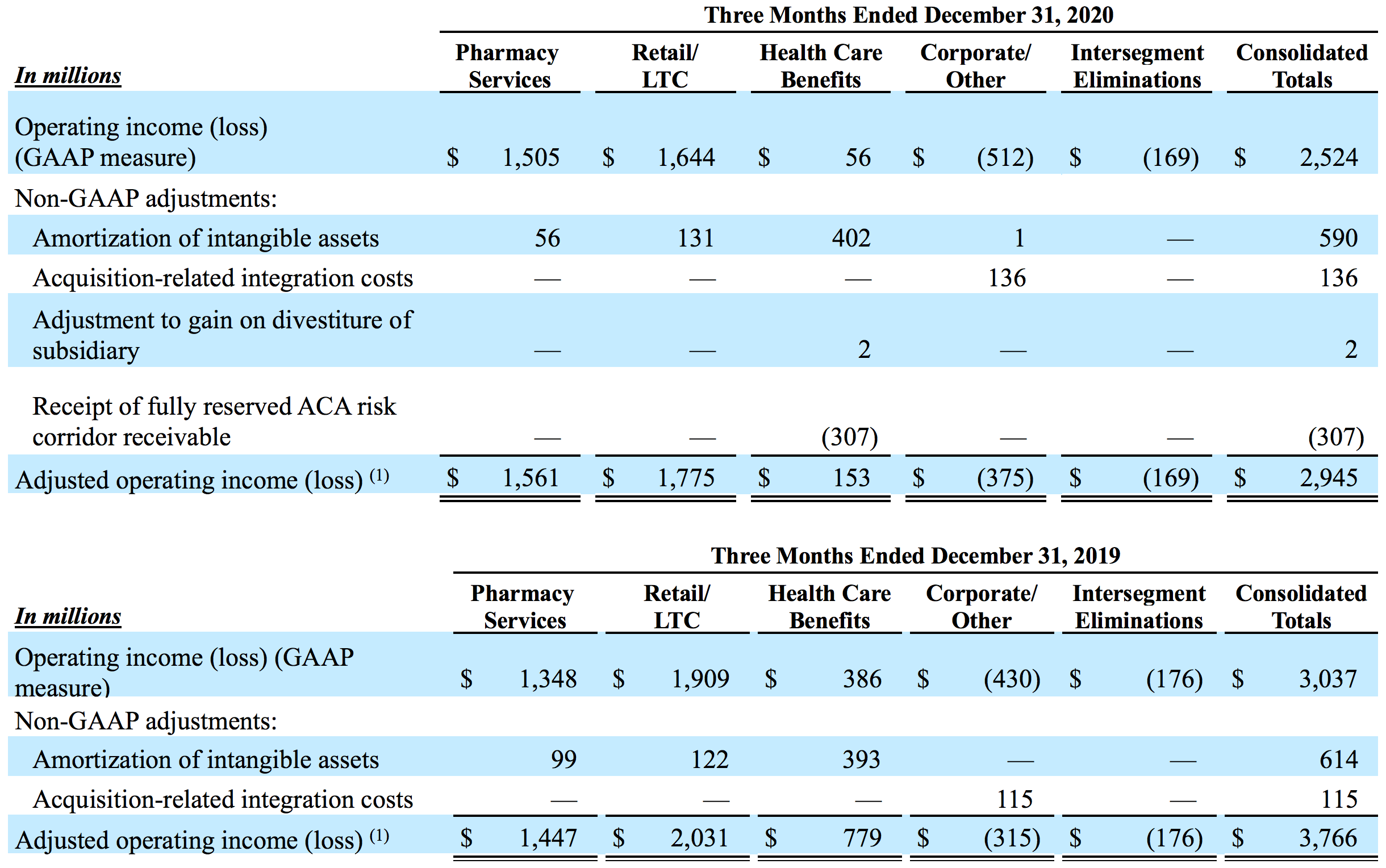
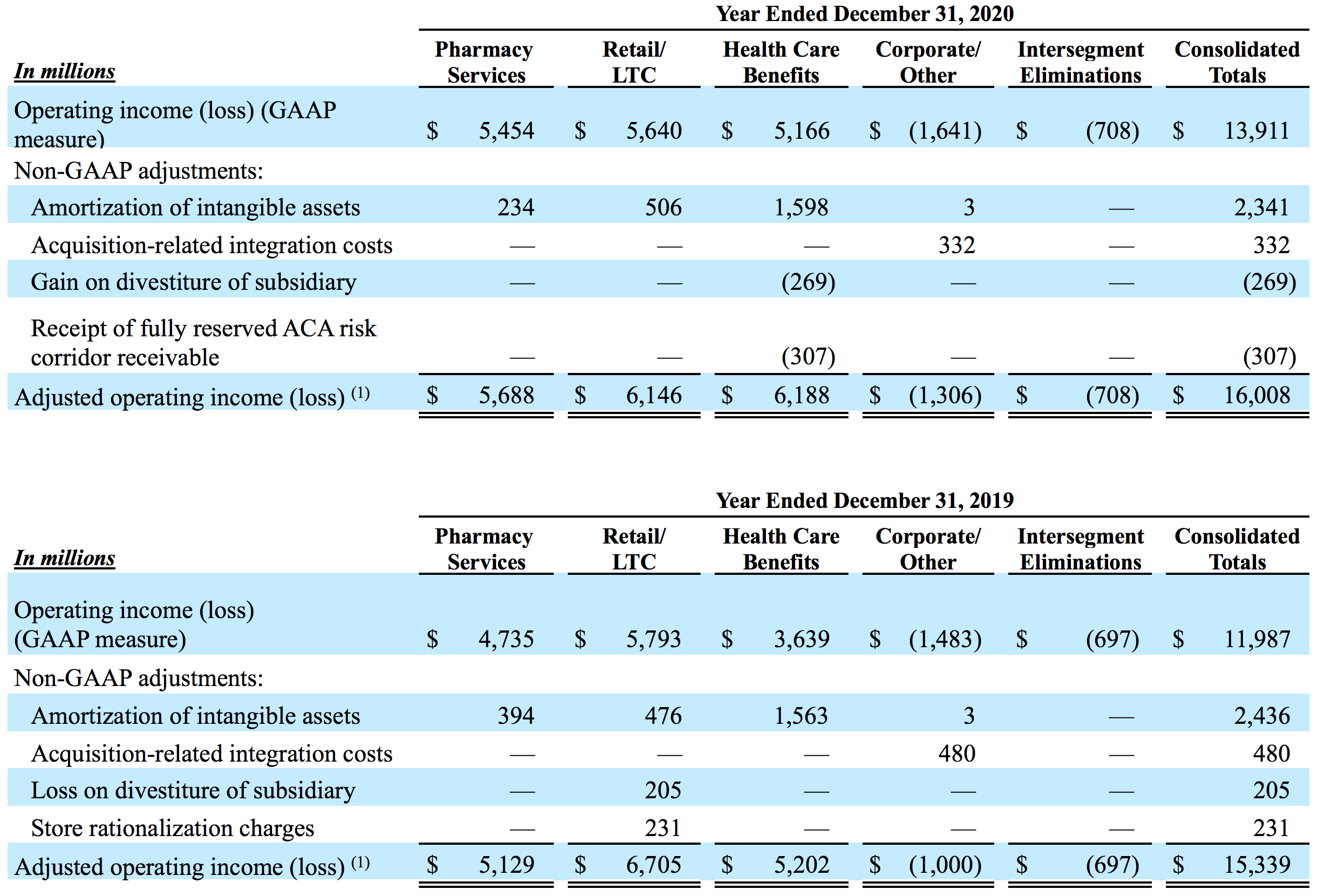
Adjusted Earnings Per Share
(Unaudited)
The following are reconciliations of income from continuing operations attributable to CVS Health to adjusted income from continuing operations attributable to CVS Health and calculations of GAAP diluted EPS from continuing operations and Adjusted EPS:
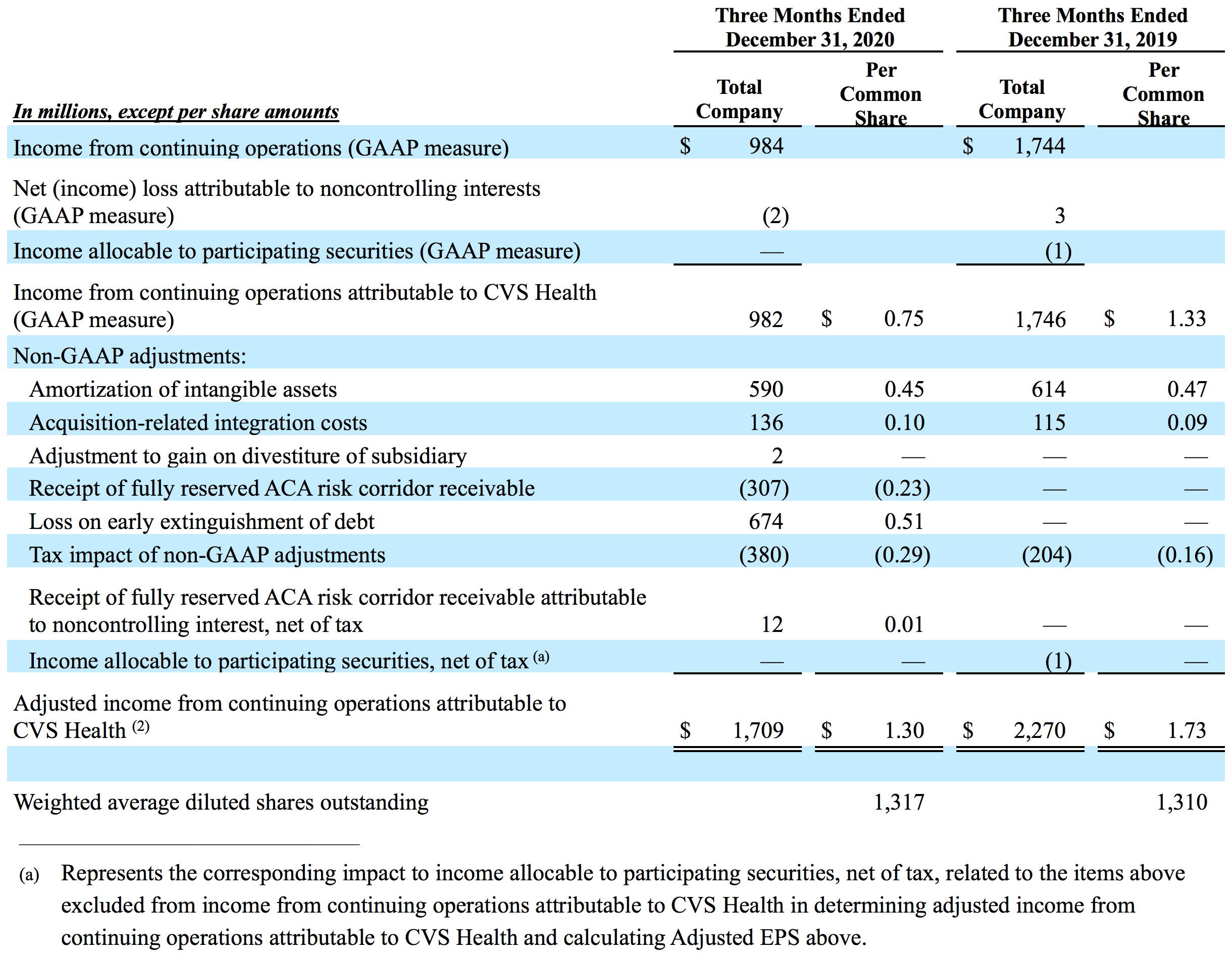
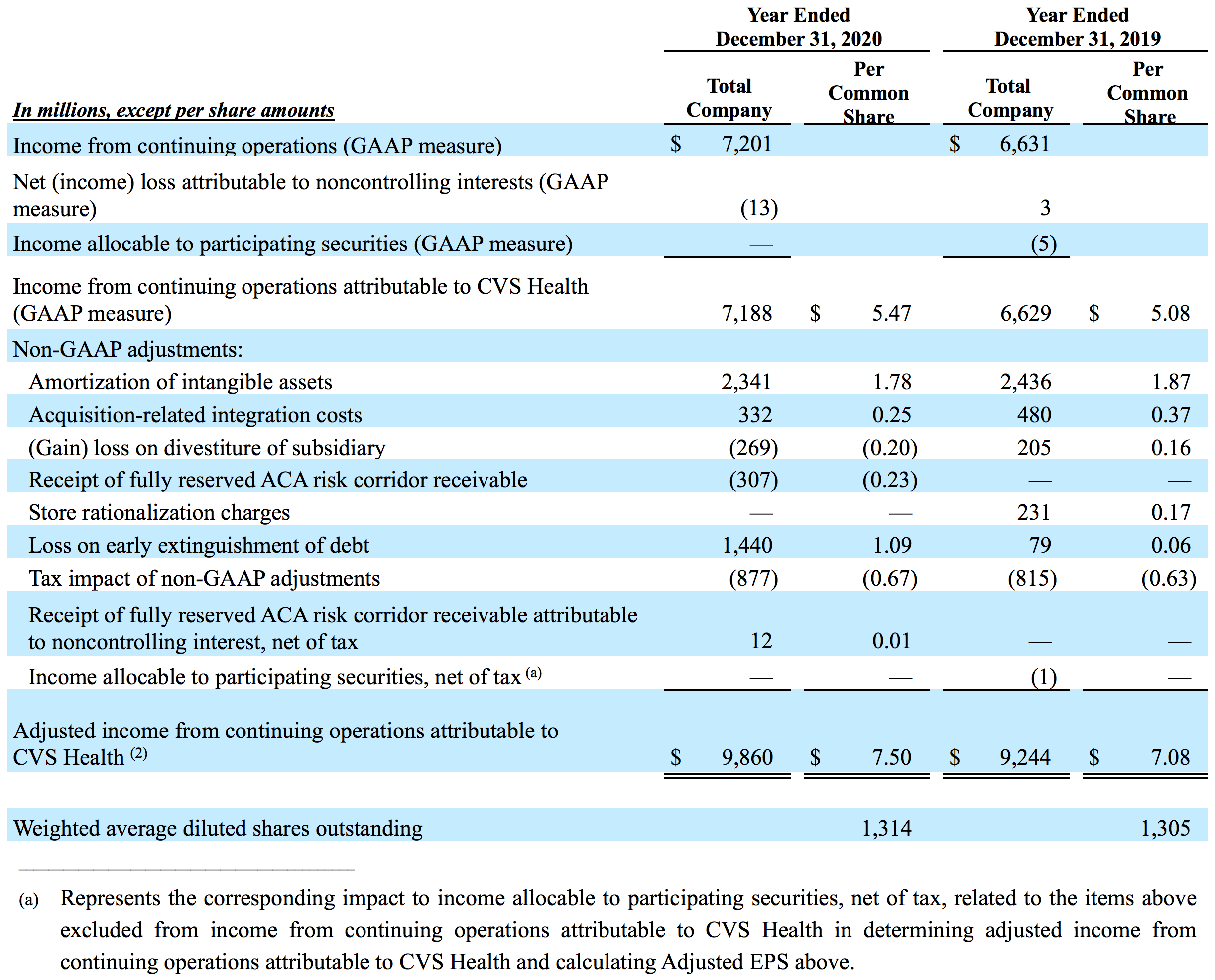
Supplemental Information
(Unaudited)
The Company’s segments maintain separate financial information, and the Company’s chief operating decision maker (the “CODM”) evaluates the segments’ operating results on a regular basis in deciding how to allocate resources among the segments and in assessing segment performance. The CODM evaluates the performance of the Company’s segments based on adjusted operating income, which is defined as operating income (GAAP measure) excluding the impact of amortization of intangible assets and other items, if any, that neither relate to the ordinary course of the Company’s business nor reflect the Company’s underlying business performance as further described in endnote (1). The Company uses adjusted operating income as its principal measure of segment performance as it enhances the Company’s ability to compare past financial performance with current performance and analyze underlying business performance and trends.
The following is a reconciliation of financial measures of the Company’s segments to the consolidated totals:

Pharmacy Services Segment
The following table summarizes the Pharmacy Services segment’s performance for the respective periods:
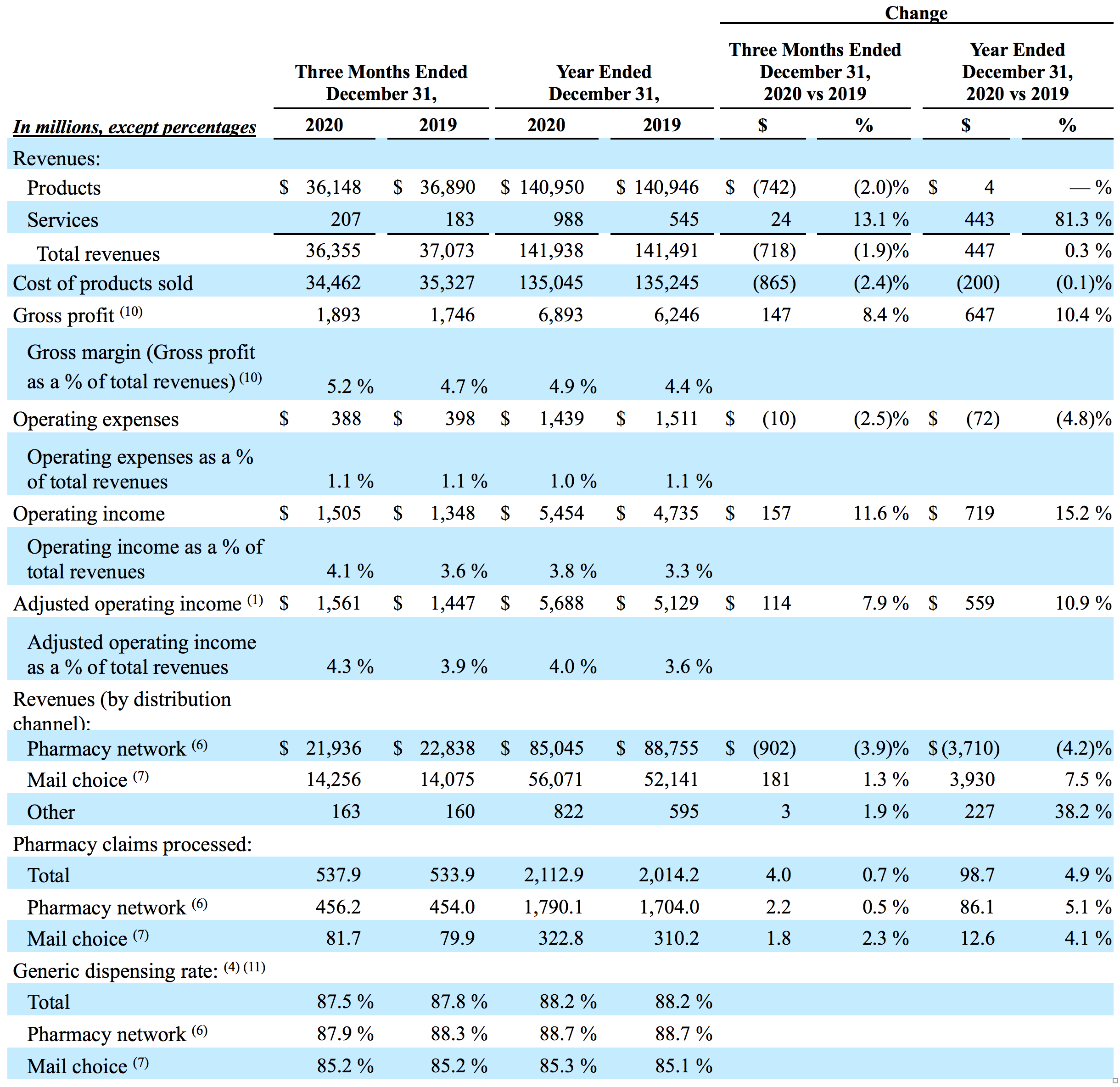
Retail/LTC Segment
The following table summarizes the Retail/LTC segment’s performance for the respective periods:
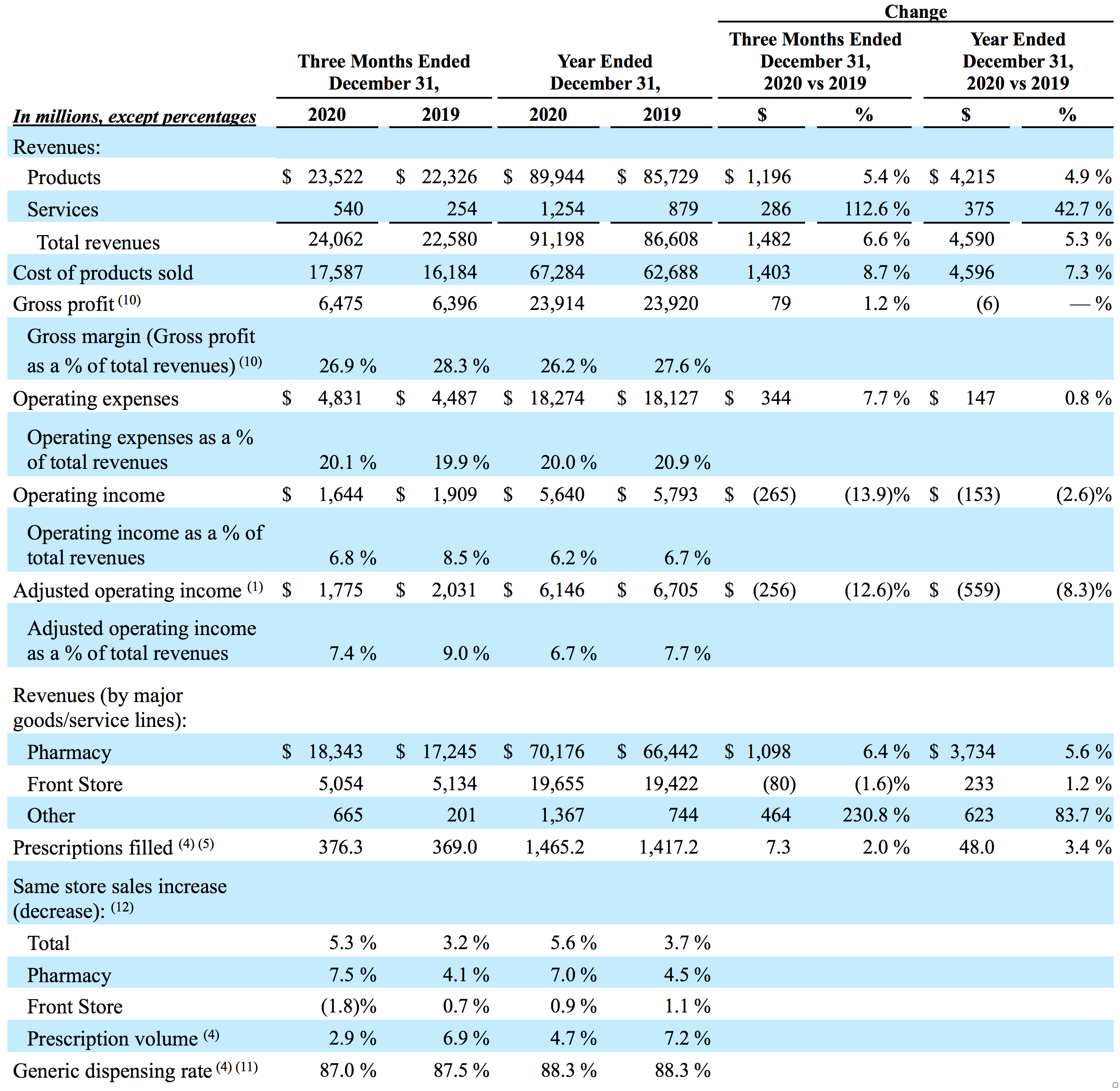
Health Care Benefits Segment
The following table summarizes the Health Care Benefits segment’s performance for the respective periods:
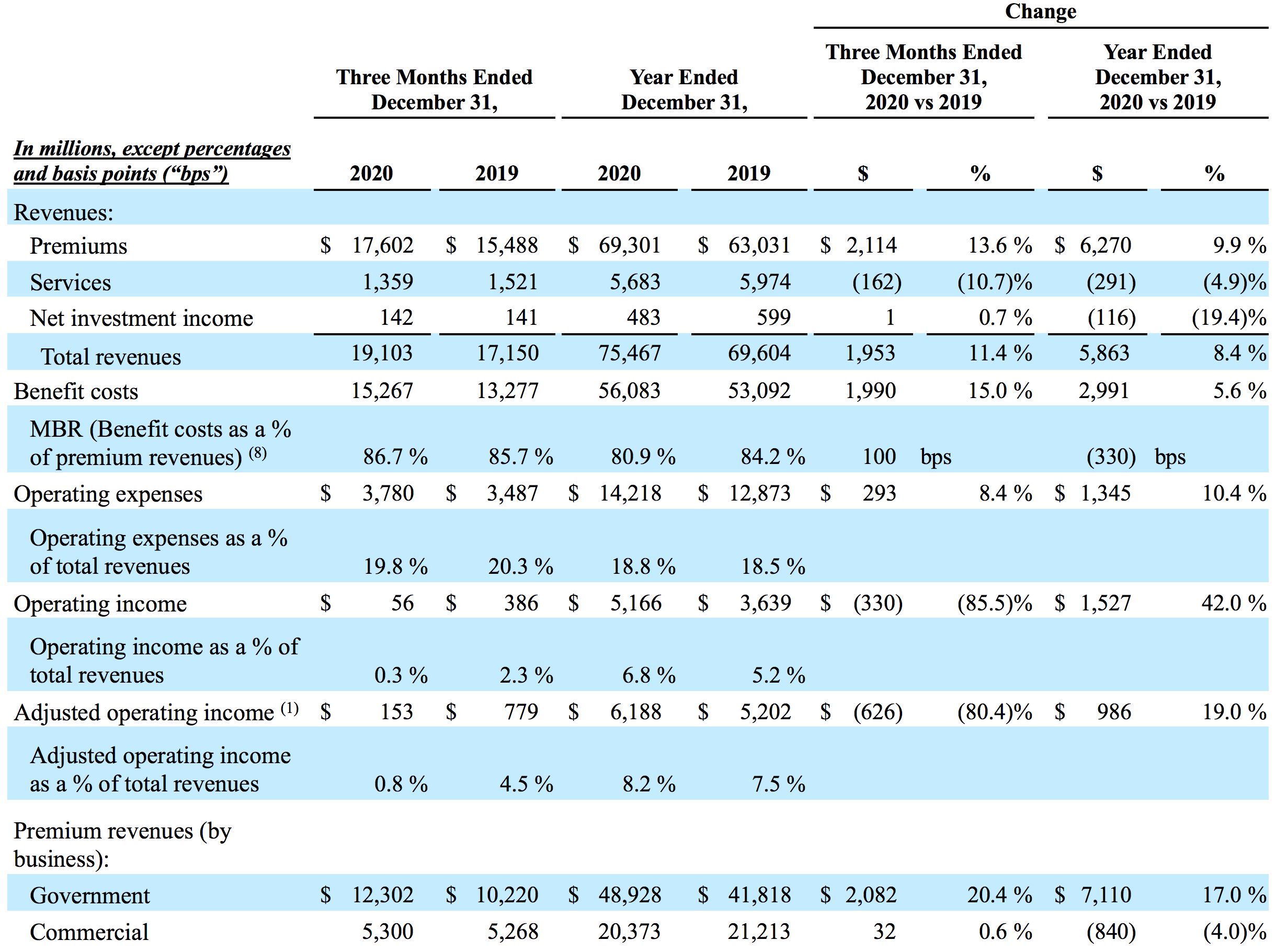
The following table summarizes the Health Care Benefits segment’s medical membership for the respective periods:
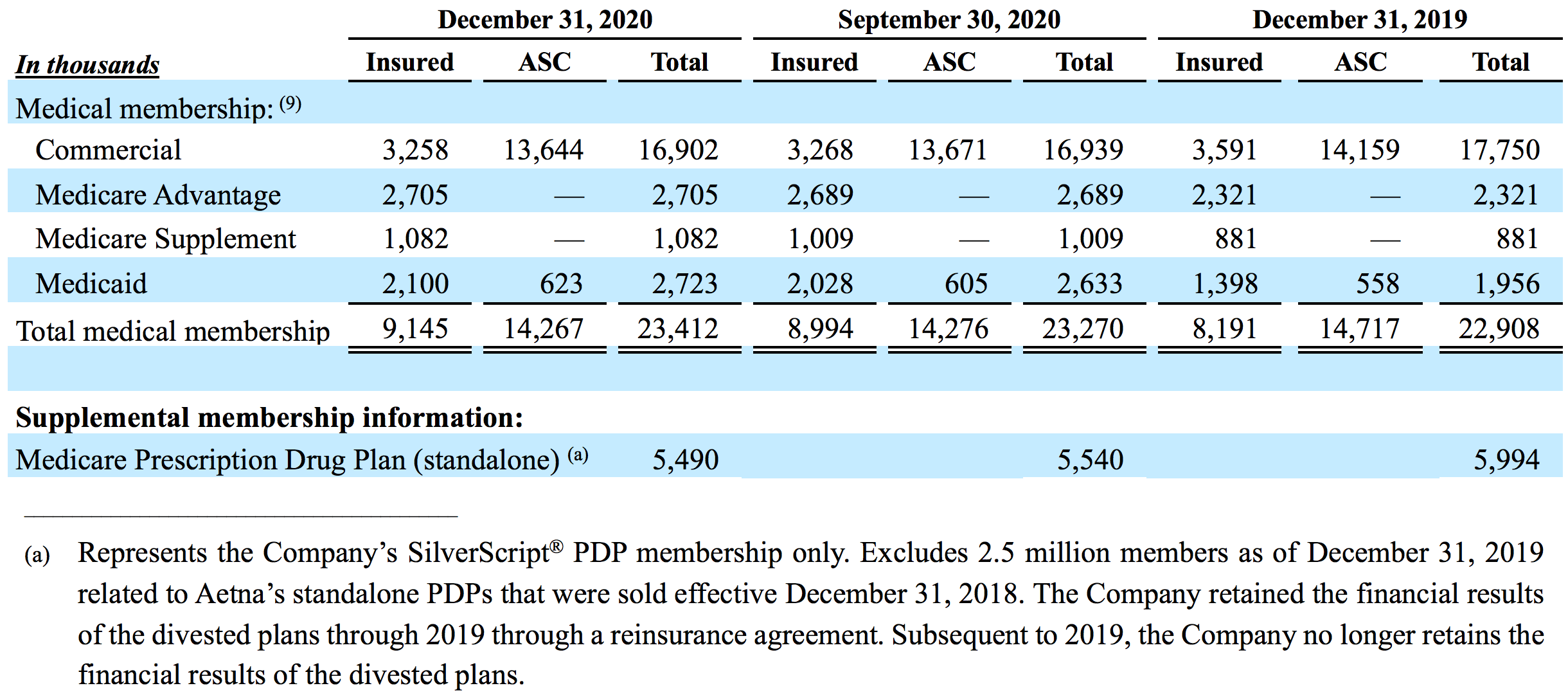
The following table shows the components of the change in health care costs payable during the years ended December 31, 2020 and 2019:
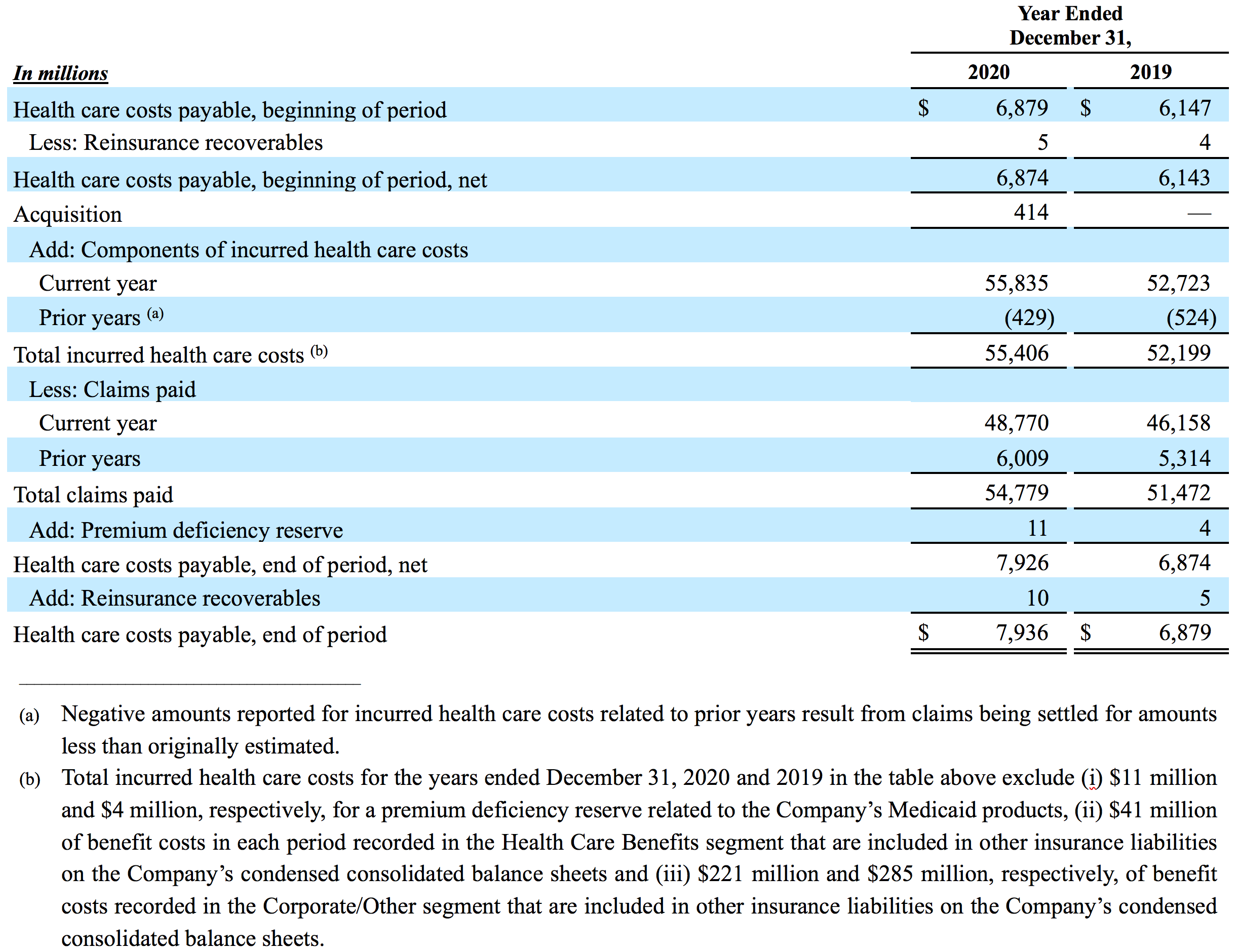
The following table summarizes the Health Care Benefits segment’s days claims payable for the respective periods:

Corporate/Other Segment
The following table summarizes the Corporate/Other segment’s performance for the respective periods:
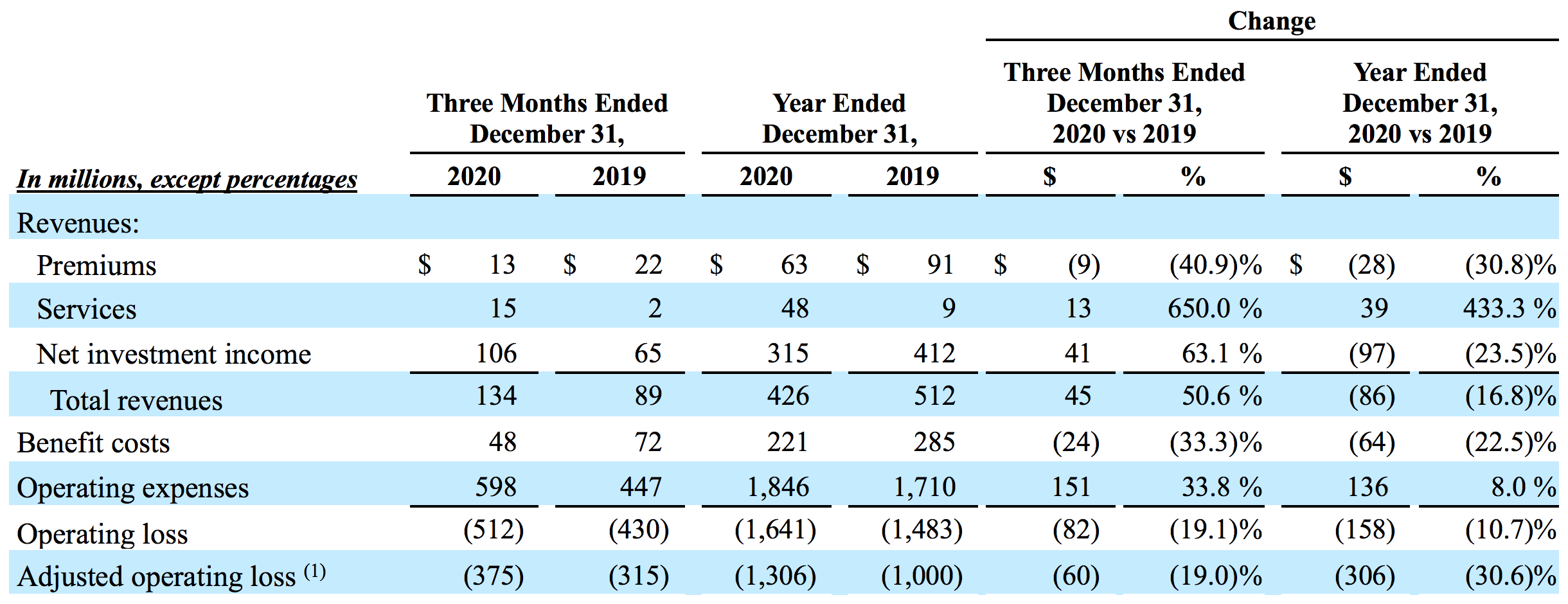
Adjusted Earnings Per Share Guidance
(Unaudited)
The following reconciliations of projected income from continuing operations to projected adjusted income from continuing operations attributable to CVS Health and calculations of projected GAAP diluted EPS from continuing operations and projected Adjusted EPS contain forward-looking information. All forward-looking information involves risks and uncertainties. Actual results may differ materially from those contemplated by the forward-looking information due to the risks and uncertainties related to the COVID-19 pandemic, the geographies impacted and the severity and duration of the pandemic, the pandemic’s impact on the U.S. and global economies and consumer behavior and health care utilization patterns, and the timing, scope and impact of stimulus legislation and other federal, state and local governmental responses to the pandemic, as well as the risks and uncertainties described in our SEC filings, including those set forth in the Risk Factors section and under the heading “Cautionary Statement Concerning Forward-Looking Statements” in our most recently filed Annual Report on Form 10-K and in our most recently filed Quarterly Report on Form 10-Q. See “Non-GAAP Financial Information” earlier in this press release and endnote (2) later in this press release for more information on how we calculate Adjusted EPS.
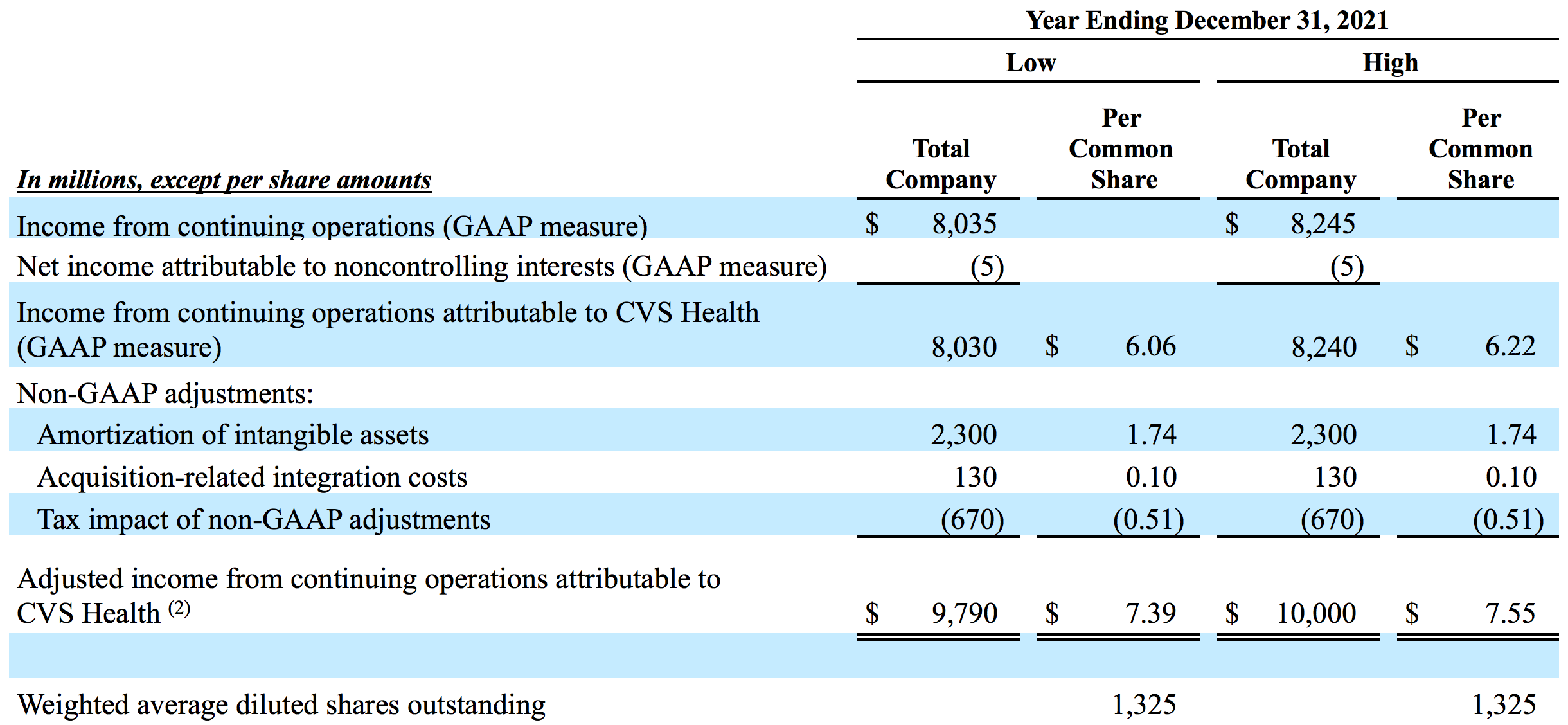
Endnotes
(1) The Company defines adjusted operating income as operating income (GAAP measure) excluding the impact of amortization of intangible assets and other items, if any, that neither relate to the ordinary course of the Company’s business nor reflect the Company’s underlying business performance, such as acquisition-related integration costs, gains/losses on divestitures, income associated with the receipt of fully reserved amounts owed to the Company under the ACA risk corridor program, store rationalization charges and any other items specifically identified herein. See “Non-GAAP Financial Information” earlier in this press release for additional information regarding the items excluded from operating income.
(2) The Company defines adjusted income from continuing operations attributable to CVS Health as income from continuing operations attributable to CVS Health (GAAP measure) excluding the impact of amortization of intangible assets and other items, if any, that neither relate to the ordinary course of the Company’s business nor reflect the Company’s underlying business performance, such as acquisition-related integration costs, gains/losses on divestitures, income associated with the receipt of fully reserved amounts owed to the Company under the ACA risk corridor program, store rationalization charges, losses on early extinguishment of debt, the corresponding income tax benefit or expense related to the items excluded from adjusted income from continuing operations attributable to CVS Health, the corresponding impact to income allocable to participating securities, net of tax, related to the items excluded from income from continuing operations attributable to CVS Health in determining adjusted income from continuing operations attributable to CVS Health, and any other items specifically identified herein. GAAP diluted EPS from continuing operations and Adjusted EPS, respectively, are calculated by dividing income from continuing operations attributable to CVS Health and adjusted income from continuing operations attributable to CVS Health by the Company’s weighted average diluted shares outstanding. See “Non-GAAP Financial Information” earlier in this press release for additional information regarding the items excluded from income from continuing operations attributable to CVS Health and GAAP diluted EPS from continuing operations.
(3) Enterprise prescriptions include prescriptions dispensed through the Company’s retail pharmacies, long-term care pharmacies, and mail order pharmacies as well as prescription claims managed through our pharmacy benefits manager, with an elimination for managed prescription claims filled through CVS Health dispensing channels. Management uses this metric to analyze the total prescription volume across the Company including variances between actual prescriptions and expected amounts as well as trends in period-over-period results. This metric provides management and investors with information useful in understanding the impact of prescription volume on total revenues and operating results.
(4) Includes an adjustment to convert 90-day prescriptions to the equivalent of three 30-day prescriptions. This adjustment reflects the fact that these prescriptions include approximately three times the amount of product days supplied compared to a normal prescription.
(5) Total pharmacy claims processed represents the number of prescription claims processed through our pharmacy benefits manager and dispensed by either our retail network pharmacies or our own mail and specialty pharmacies. Prescriptions filled represents the number of prescriptions dispensed through the Retail/LTC segment’s pharmacies. Management uses these metrics to understand variances between actual claims processed and prescriptions dispensed, respectively, and expected amounts as well as trends in period-over-period results. These metrics provide management and investors with information useful in understanding the impact of pharmacy claim volume and prescription volume, respectively, on segment total revenues and operating results.
(6) Pharmacy network is defined as claims filled at retail and specialty retail pharmacies, including the Company’s retail pharmacies and long-term care pharmacies, but excluding Maintenance Choice activity, which is included within the mail choice category. Maintenance Choice permits eligible client plan members to fill their maintenance prescriptions through mail order delivery or at a CVS Pharmacy retail store for the same price as mail order.
(7) Mail choice is defined as claims filled at a Pharmacy Services mail order facility, which includes specialty mail claims inclusive of Specialty Connect® claims picked up at a retail pharmacy, as well as prescriptions filled at the Company’s retail pharmacies under the Maintenance Choice program.
(8) Medical benefit ratio is calculated as benefit costs divided by premium revenues and represents the percentage of premium revenues spent on medical benefits for the Company’s insured members. Management uses MBR to assess the underlying business performance and underwriting of its insurance products, understand variances between actual results and expected results and identify trends in period-over-period results. MBR provides management and investors with information useful in assessing the operating results of the Company’s insured Health Care Benefits products.
(9) Medical membership represents the number of members covered by the Company’s insured and ASC medical products and related services at a specified point in time. Management uses this metric to understand variances between actual medical membership and expected amounts as well as trends in period-over-period results. This metric provides management and investors with information useful in understanding the impact of medical membership on segment total revenues and operating results.
(10) Gross profit is calculated as the segment’s total revenues less its cost of products sold. Gross margin is calculated by dividing the segment’s gross profit by its total revenues and represents the percentage of total revenues that remains after incurring direct costs associated with the segment’s products sold and services provided. Gross margin provides investors with information that may be useful in assessing the operating results of the Company’s Pharmacy Services and Retail/LTC segments.
(11) Generic dispensing rate is calculated by dividing the segment’s generic drug prescriptions processed or filled by its total prescriptions processed or filled. Management uses this metric to evaluate the effectiveness of the business at encouraging the use of generic drugs when they are available and clinically appropriate, which aids in decreasing costs for client members and retail customers. This metric provides management and investors with information useful in understanding trends in segment total revenues and operating results.
(12) Same store sales and prescription volume represent the change in revenues and prescriptions filled in the Company’s retail pharmacy stores that have been operating for greater than one year, expressed as a percentage that indicates the increase or decrease relative to the comparable prior period. Same store metrics exclude revenues from MinuteClinic, revenues and prescriptions from LTC operations and, in 2019, revenues and prescriptions from stores in Brazil. Management uses these metrics to evaluate the performance of existing stores on a comparable basis and to inform future decisions regarding existing stores and new locations. Same-store metrics provide management and investors with information useful in understanding the portion of current revenues and prescriptions resulting from organic growth in existing locations versus the portion resulting from opening new stores.
(13) Days claims payable is calculated by dividing the health care costs payable at the end of each quarter by the average health care costs per day during such quarter. Management and investors use this metric as an indicator of the adequacy of the Company’s health care costs payable liability at the end of each quarter and as an indicator of changes in such adequacy over time.
Contacts
Investors
Valerie Haertel
Senior Vice President
Investor Relations
401-770-4050
Media
T.J. Crawford
Vice President
External Affairs
212-457-0583
